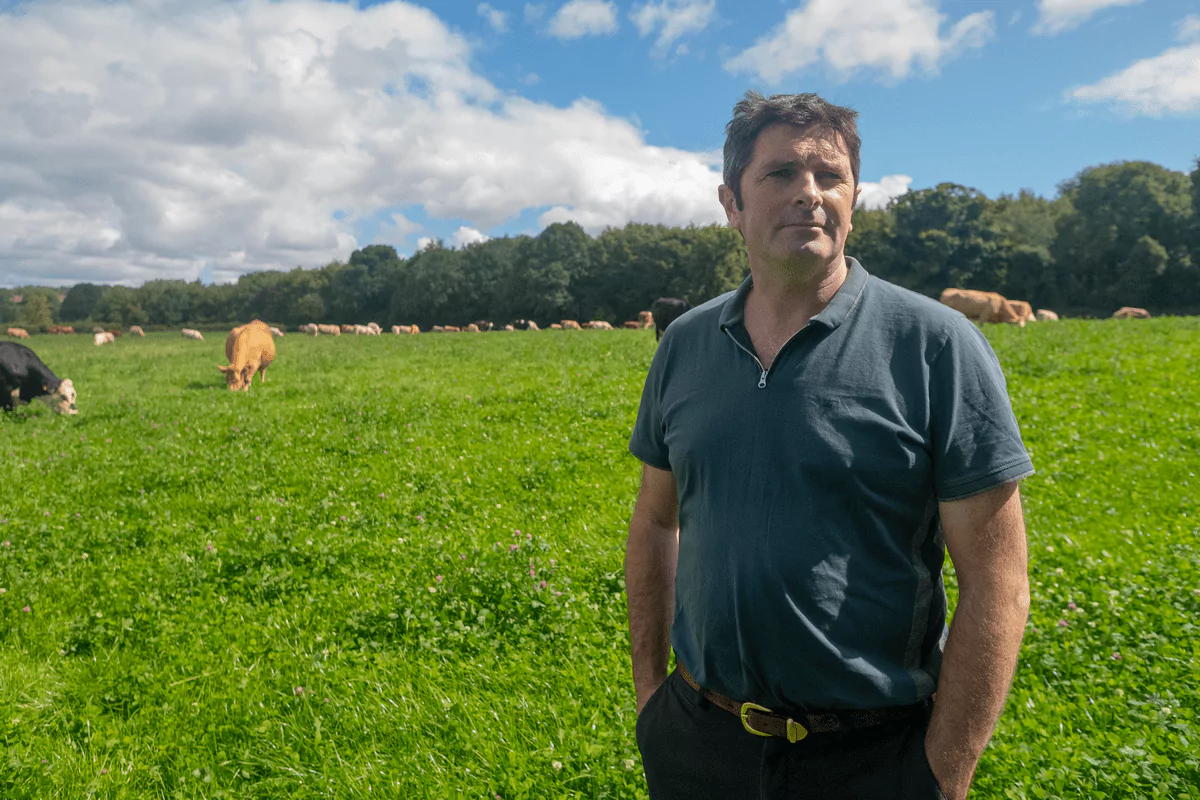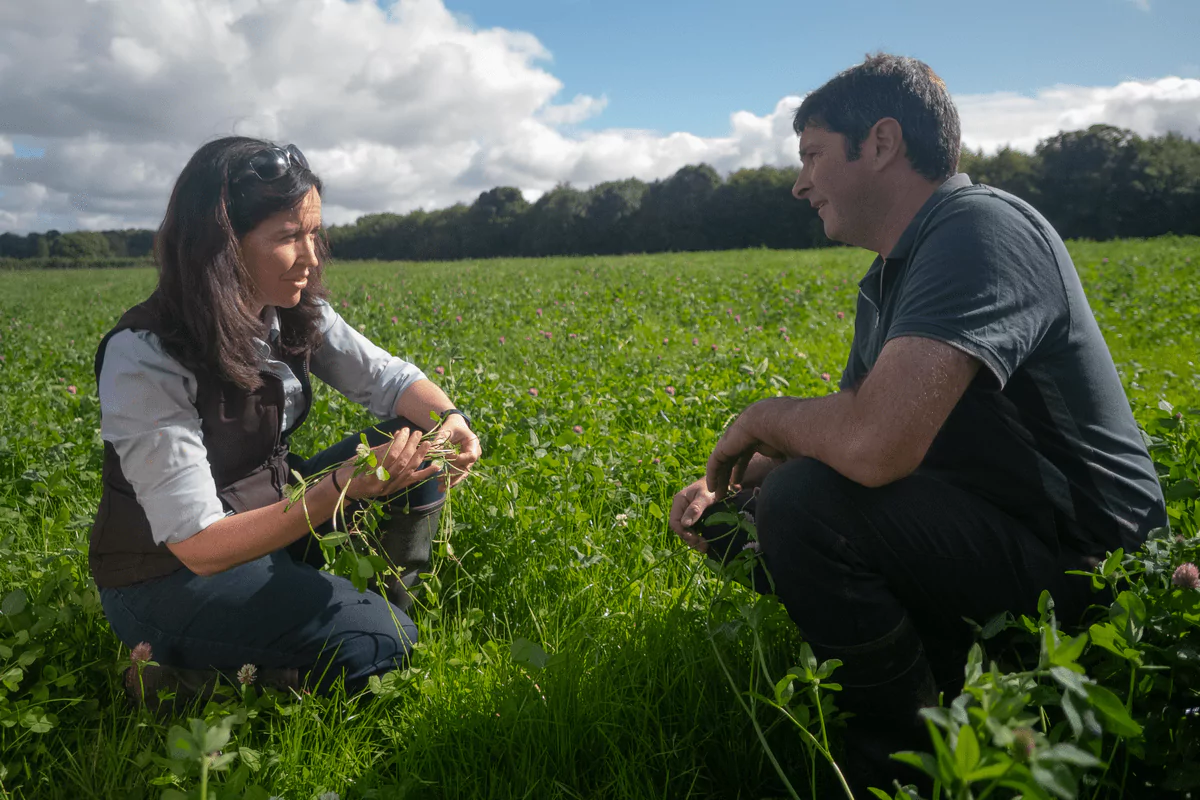Kilkenny farmer Jimmy Madigan is already seeing economic and environmental benefits since reseeding with climate smart grasses and clovers in 2022. Find out how Jimmy is beginning to cut back on an annual nitrogen bill of €30,000.
Jimmy's sustainable farming success was recognised when he was honoured as a finalist in the Germinal Sustainable Pasture Farmer of the Year category at the 2023 Better Farming Awards.
The Kilkenny farm covers 237 acres of owned land with 15 acres rented. A main block in Ballyhale comprises 150 acres, which is supported by two outblocks totalling 85 acres and a further 15 acres of rented land.
Farm facts: Madigan Farm
- Ballyhale, Co. Kilkenny
- 252 acres farmed
- Suckler beef system
- 50-60 bulls
- 85-90 cows for calving
- 200 store lambs
- Finishing 150 cattle per year
Suckler beef system
Primarily suckler beef farmers, the family also have 50 to 60 bulls and 200 store lambs that are finished over winter.
“Our suckler system is a 50-50 autumn and spring calving herd,” Jimmy explains. “50 females go to the bull for calving in August and September, with 50 females going to the bull for calving in January, February and March. So, we normally end up with around 85-90 cows calving down and anything that is empty is culled.”
As for sheep, store lambs are purchased in August and September for grazing until the new year, with the first lambs sent to the factory in January.
But it’s primarily a beef farm, Jimmy explains: “We finish roughly 150 cattle per year. All stock that is produced on-farm is finished on-farm.”
Grassland management
The farm is reasonably dry, allowing for a long grazing season. Paddocks measure from two to five acres, with most coming in at three and four acres. Jimmy’s rotational system lets stock graze for three days and then paddocks are rested for three weeks.
As for silage, Jimmy has implemented a two-cut system and avoids cutting the same land every year. “We rotate our silage ground as we find it is better for the land,” Jimmy adds.
A certain proportion of each block is cut for silage each year, allowing flexibility for drought or poor weather.
“We can move in and out of silage ground when grass gets too plentiful, and we can use some grassland as silage. Or, when grass gets too scarce, we can move into silage ground,” Jimmy clarifies.

Farming in difficult weather
Faced with heavy rainfall and wet conditions, cattle are moved every one or two days to reduce sward damage rather than every three days.
When it comes to drought conditions, Jimmy buffer feeds his cows. “We have an advantage here with the two separate herds; we can wean calves at different times of the year and house animals at different times of the year.”
Reseeding with grass and clover
Discussing his preferred grassland reseeding methods, Jimmy focused on a field reseeded with perennial ryegrass plus red and white clover on 23rd April 2023.
Working with Germinal, Jimmy helped devise a mixture that featured AberGain and AberChoice perennial ryegrasses from the Aber High Sugar Grass range with AberClaret red clover and AberHerald white clover. After a successful introduction in 2022, Jimmy wants to keep going.
“When selecting grass seed mixtures, we want good grass cover for good cuts of silage, quality bulk cuts of silage, and aim for a long grazing season and grass that grows well on the shoulder periods of the year.
“The plan for the future is to incorporate this mixture in all our reseeding programmes over the next number of years.”
Burnt off with glyphosate in March 2022, the field was disced twice and sown with a one-pass system. Three bags of 13-6-20 plus sulphur were applied to aid establishment and rolled after.
First grazed on 14th June 2022, Jimmy maintained his three-week interval strategy for the remainder of the year. Lambs were then stored over winter the field was cut on 16th May 2023, yielding eight-and-a-half bales to the acre.
“The beauty of this field is that it has great forage quality and we’re producing very high-quality silage, which is reducing the need for purchased protein – it’s all grown here on-farm.”
Climate smart production
Combining grass and clover is also boosting production while unlocking environmental benefits. “We’re seeing improved weight gain across all groups of animals. Plus, it’s receiving no chemical nitrogen, which is a big benefit to my pocket and a big benefit to the environment,” Jimmy reveals.
He believes that reducing chemical nitrogen use is fundamental to sustainable grassland management. “The use of organic manures and the use of red clover and white clover needs to happen going forward.
“We introduced red clover for the first time in April 2022 because we wanted to be climate smart going forward. The climate is in trouble worldwide and we need to do our bit.
 “I feel clover swards are the way forward on this farm,” Jimmy adds. “We are getting better animal performance, we’re getting equal yields on our silage ground with no applications of nitrogen, and our animals are doing better plus we can produce a high-protein crop which reduces the need for expensive imported protein.
“I feel clover swards are the way forward on this farm,” Jimmy adds. “We are getting better animal performance, we’re getting equal yields on our silage ground with no applications of nitrogen, and our animals are doing better plus we can produce a high-protein crop which reduces the need for expensive imported protein.
Business-wise, Jimmy explains that the farm is running more efficiently and spending less on artificial nitrogen fertiliser.
“We see our cattle thriving and we can see our grass growth is exceptional. If I can grow plenty of high-quality forage and grass at a lower cost to my pocket going forward, then it’s definitely the way to go on this farm.”
“Our annual nitrogen bill in 2023 was somewhere in the region of €30,000. I don’t think that is sustainable on my part and it is not sustainable for the environment either,” Jimmy concludes.
Ask us about climate smart production
Interested in adding highly productive, climate smart grass and forage to your livestock system? Submit the form below and start talking to your nearest Germinal expert.
